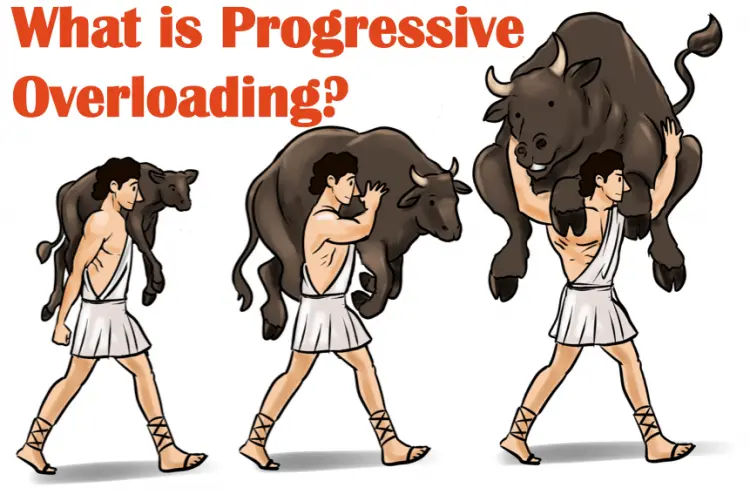Building muscle and strength are time-consuming and energy-sapping processes. Simply put, your body is very resistant to change, and it needs to be cajoled and even bullied into getting bigger and stronger.
However, all your hard work and dedication WILL pay off, and as the months turn into years, you’ll gradually transform your physique into one you can be proud of.
Or that’s the theory, at least!
Unfortunately, many lifters fail to see the results their efforts deserve. They show up at the gym regularly, hoist some weights, and slam their protein shakes but still see very little progress.
For them, bodybuilding is an endless treadmill of frustration and disappointment. It’s enough to make you weep!
While rates of progress are often determined by factors beyond your control, such as your body type and genetics, everyone can build muscle. However, some people inadvertently sabotage their results by making otherwise avoidable mistakes.
Level Up Your Fitness: Join our 💪 strong community in Fitness Volt Newsletter. Get daily inspiration, expert-backed workouts, nutrition tips, the latest in strength sports, and the support you need to reach your goals. Subscribe for free!
In this article, we reveal the FIVE most common muscle-building mistakes you NEED to stop making today!
Mistake #1 – Training Like A Champ, But Eating Like A Chump

While training is the stimulus for muscle growth, your diet provides your body with the materials and energy it needs to adapt to and recover from your workouts. It doesn’t matter how hard or consistently you train; if the food you eat doesn’t support your training, your progress will always be suboptimal.
It’s beyond the scope of this article to tell you exactly what to eat for muscle building, but here are a few hints and tips that’ll make it easier:
Calories
The energy in your food is measured in calories. Building muscle is generally easier when there is a calorie surplus. This means you consume more calories than you burn. A 300-500 calorie surplus is usually sufficient. Still, you may need a larger surplus if you have a fast metabolism, are a hard gainer, or have a physically demanding job, e.g., a laborer.
Not eating enough is a leading cause of muscle-building plateaus. As bodybuilders often say, if you want to get big, you’ve got to eat big.
Protein
While your caloric intake matters, where those calories come from is also important. There are three macronutrient groups, known as macros, and protein is arguably the most critical for building muscle.
Protein contains amino acids, which are the building blocks of muscle tissue. Your body uses amino acids to repair the damage caused by your workouts and build your muscles back bigger and stronger. While you can build muscle with insufficient protein, it’s a much more challenging and slower process compared to consuming enough.
Most bodybuilders should consume 0.7 to 1.0 grams of protein per pound of body weight. Alternatively, you can use this protein calculator to determine your protein needs. Good sources of dietary protein include:
- Chicken breast
- Chickpeas (v)
- Cottage cheese
- Eggs
- Greek yogurt
- Lentils (v)
- Quinoa (v)
- Salmon
- Tofu (v)
- Whey protein powder
Food quality
There is a saying in computer technology – garbage in, garbage out. This basically means that, in the context of computing and data analysis, the quality of the output is directly influenced by the quality of the input. In other words, if you input poor or inaccurate data, you can expect poor or inaccurate results.
This saying can also be applied to eating for muscle building.
You need more than protein and calories to burn muscle, and the quality of your food matters just as much as how much you eat.
For example, when faced with choosing between eating a cookie or an apple, many people will choose the sweet-tasting cookie. However, despite being similar in size, they’re nutritionally very different, and the apple is far healthier.
Apple:
- Calories: 95 kcal
- Carbohydrates: 25g
- Dietary Fiber: 4.4g
- Sugars: 19g
- Protein: 0.5g
- Fat: 0.3g
Vitamins and Minerals: Apples are a good source of vitamin C and contain various other vitamins and minerals.
Average Cookie:
- Calories: 140 kcal
- Carbohydrates: 19g
- Dietary Fiber: 0.6g
- Sugars: 10g
- Protein: 1.4g
- Fat: 6.9g
- Saturated Fat: 3.7g
Vitamins and Minerals: Cookies generally do not provide significant amounts of vitamins and minerals.
While there is space in any diet for a few cheats and treats, most of what you eat should be healthy and nutritious. That way, you’ll get all the nutrients your body needs to thrive and grow. Building muscle is far easier when you are healthy, and being healthy starts with your diet.
Mistake #2 – Not Following a Progressive Program
It’s often said that you are only as fit as your last workout, and the same can be applied to strength and bodybuilding training. Your body will only adapt as far as your workouts demand, so if your training intensity stays the same, so will your muscles.
For example, if you bench press 225lbs, your body will adapt to the demands of that weight. However, your muscles will not adapt further if the stimulus remains the same.
To keep your gains coming, you need to gradually turn up the intensity of your workout so your muscles are exposed to ever more challenging stimuli. This is called progressive overload.
Many lifters assume that progressive overload means changing your workout every few weeks, but this is only one part of the muscle growth equation. Instead, each new program should look like a wedge of cheese – narrow at one end and wide at the other.
Over several weeks, your workout should gradually become more demanding until you hit a plateau. At that point, you start a new program and begin the build-up process again.
For example – barbell bench press:
- Week 1: 3 sets of 8 reps 175lbs.
Week 2: 3 sets of 9 reps 175lbs. - Week 3: 3 sets of 10 reps 175lbs.
- Week 4: 3 sets of 8 reps 185lbs.
- Week 5: 3 sets of 9 reps 185lbs.
- Week 6: 3 sets of 10 reps 185lbs.
- Week 7: Switch exercises/programs
To continue overloading your muscles, you can increase your reps, do more sets, lift more weight, reduce the rest between sets, employ a training system, or use a combination of these methods. However you do it, you must keep trying to push yourself harder. If you don’t, your progress will soon grind to a halt.
You can read more about progressive overload in this in-depth guide.
Mistake #3 – Not Paying Attention to Form
Read any of our workout guides, and you’ll see that Fitness Volt writers are sticklers for good form. Every program we publish includes step-by-step instructions, so you know how to do each exercise.
This isn’t because we’re a bunch of control freaks. Instead, it’s because doing an exercise correctly will produce better results than doing it incorrectly, and it is almost always safer, too.
Consider this example:
It’s Monday, so it’s chest training day. You join the bench press queue, and eventually, it’s your turn to train. You slam three plates on either side, get under the bar, unrack it, and then proceed to lower the bar quickly and bounce it off your chest. You contort your body every which way to complete your reps and then rerack the bar feeling satisfied. The next day, your joints hurt, but you figure that’s normal (it isn’t).
While your workout may have looked impressive (three plates, bro!), your muscles actually did very little work, and most of the energy came from the elasticity of your shoulder joints, tendon, and rib cage. Someone points this out to you, so you agree to do things differently next week.
After all, what can it hurt, right?
So, you load the bar with half the usual weight. After unracking the bar, you lower it under control to lightly touch your chest, pause for 1-2 seconds, and then drive it back up powerfully and smoothly. You feel each rep in your pecs, and each rep gets progressively harder, but you stick to your smooth cadence and perfect form. By the end of the set, your pecs are screaming for mercy and pumped to the max. The next day, your joints feel fine, but your muscles are super-sore.
Congratulations – you just had a productive workout!
Performing the exercises in your workout with good form will:
- Keep the tension on the target muscles.
- Keep tension away from nearby joints and muscles.
- Make your chosen exercise harder so you don’t need to use so much weight.
- Improve your mind-muscle connection.
- Minimize your risk of injury.
It’s beyond the scope to tell you how to perform all the exercises in your workouts, but, in general, you should:
- Lower the weight under control.
- Pause for 1-2 seconds.
- Drive the weight up powerfully.
Pause for 1-2 seconds. - Maintain a smooth cadence for your entire set.
- Keep the rest of your body stationary, and only move the limbs you are training.
Invariably, this means using less weight than your ego wants you to. But, in this instance, letting your ego choose your training weights could undermine muscle growth, so you’ll need to learn to ignore it.
This doesn’t mean you should train with light weights. However, it’s essential to understand that how you lift the load is as important as the overall poundage. Sometimes, less weight is actually better for muscle growth.
Mistake #4 – Lack of Consistency
Consistency is one of the most critical factors in determining your muscle and strength-building success. Being consistent means showing up at the gym regularly and not missing workouts. Even if you do almost everything wrong, if you are consistent, you’ll probably still make reasonable progress.
There are several ways you can stack the “consistency deck” in your favor and avoid missing workouts unnecessarily. These include:
Choose a workout and exercises you enjoy
It is more tempting to skip workouts that you don’t enjoy. Humans are very good at avoiding those tasks we find laborious, painful, or boring. One way around this problem is to plan your training around exercises you enjoy.
- Sick of squats? Do leg presses instead!
- Dread deadlifts? Try some barbell hip thrusts!
- Bored of the bench press? Use the chest press machine!
Ultimately, you’ll get better results from slightly inferior exercises done consistently than you’ll get from the best exercises done infrequently.
Under-commit and over-deliver
A lot of workouts demand vast amounts of time and energy. That’s fine when you are well-rested and your life is going smoothly, but when the universe seems to want to keep you out of the gym? Invariably, when time and energy are short, the first casualty will be your workout.
Avoid this problem by choosing a workout plan you know you can CRUSH, even on your worst day. Commit to hitting the gym four times a week for an hour, and consider it a bonus if you can go more often or for longer.
Keep it simple (stupid)
Some workouts seem to be designed to be as complicated as possible. Things like prescriptive tempos, weight percentages, reps in reserve, exotic movements, convoluted split routines, and variable rest periods mean you need an exercise science degree to understand what you’re meant to be doing.
All this complexity is unnecessary and a justifiable reason for skipping your workout. Training should allow you to unplug your brain and unleash your inner animal, not leave you looking up definitions and explanations on your phone.
If your training program leaves you feeling more puzzled than motivated, it’s time to get back to basics and adopt a more straightforward training program. And remember, complexity doesn’t build muscle – effort and consistency do.
Level Up Your Fitness: Join our 💪 strong community in Fitness Volt Newsletter. Get daily inspiration, expert-backed workouts, nutrition tips, the latest in strength sports, and the support you need to reach your goals. Subscribe for free!
How simple? How’s this for a no-frills barbell and bodyweight workout plan?
| Exercise 1 | Exercise 2 | Exercise 3 | Exercise 4 | |
| Monday | Front squat | Bench press | Bent-over row | Leg raises |
| Wednesday | Deadlift | Overhead press | Pull-up | Woodchop |
| Friday | Back squat | Dip | Barbell curl | Side plank |
Do something like five sets of five, four sets of six, or three sets of eight of each exercise to build muscle and strength.
Have a plan B
The military has a saying: no plan survives first contact with the enemy. Life has a way of trying to derail even the best-laid plans, but that doesn’t have to mean you can’t keep to your workout schedule. What you need is a plan B.
Having a backup plan means you can still meet your training objectives, even if it involves a slightly different workout approach from what you’re used to.
For example, if you can’t get to the gym to do your usual chest workout, do a push-up workout at home. While this won’t be quite as effective as what you had planned, it’s 1000% better than doing nothing.
Alternatively, keep a set of adjustable dumbbells or resistance bands at home so you can stay on top of your training and won’t miss out even if you can’t hit the gym for your regular workout.
In almost every case, any workout is better than no workout.
Never miss two workouts in a row
Even if you adopt these habits, at some point, you will be forced to miss a workout. When this happens to you, the first thing to remember is one missed workout isn’t the end of the world, and the occasional missed workout won’t hurt your progress.
That said, you should get into the habit of never missing two workouts in a row. That way, you’ll stay on track even if you do experience the occasional slip-up.
So, one way or another, make missed workouts a singular event and do everything you can to get back in the gym for your next scheduled training session. And while this may mean working out on a rest day or rearranging the rest of that week’s program, do whatever you can to get back on track ASAP.
Related: 7 Proven Habits for More Consistent Workouts
Mistake #5 – Not Paying Enough Attention to Rest and Recovery
While a lot of exercisers are genuine gym heroes and love pushing themselves through intense workouts, many of those same people fail to understand the importance of rest and recovery.
Training is like digging a hole – it takes a lot out of you. Rest and recovery fill that hole so you can come back rested, bigger, stronger, and ready for more. Too little attention to rest and recovery means the hole keeps getting deeper, and it can become tough to climb back out.
If you want to train hard and often, you MUST prioritize rest and recovery. Ways to do this include:
Getting enough sleep
Sleep is when your body gets busy recharging your batteries and repairing the muscle microtrauma caused by your workouts. To facilitate this, anabolic (muscle-building) hormones such as testosterone and growth hormone are produced in more significant amounts while you sleep.
Too little sleep can hurt your gains and rob you of the energy you need to work out. Most people need 7 to 9 hours of sleep per night. That’s every night – not just at weekends. Invariably, this means going to bed earlier, but remember, as you sleep and dream of better gains, your body will actually be busy making those dreams come true!
Read more about the importance of sleep here.
Rest days
You can’t train every day and expect to keep making progress. Eventually, your workouts will overtake your body’s ability to recover and adapt, and your progress will stall. As such, the best training programs include days off where you can rest, gather your energy, and return to the gym full of motivation and vitality.
However, what you do on those non-training days is also important, and it’s all too easy to squander your energy and impede your recovery. For example, if your idea of a rest day from the gym is to hike 10 miles, run a 5k, or play two hours of basketball, you are not providing your body with the break it needs.
We’re not saying you need to be entirely sedentary on your rest days, but you should avoid overtaxing yourself. Be active, but don’t do so much that you end up feeling more tired.
In addition, it’s okay to take unplanned rest days if you feel tired. Things like stress, a day of poor eating, or a disrupted night’s sleep may mean you aren’t ready for your next workout. Providing you really are tired and aren’t just being lazy, an extra day off could be precisely what you need to return to the gym feeling stronger and more energized.
Eat healthily
We’ve already talked about the importance of diet and nutrition for building muscle. Still, it’s worth reiterating as what you eat is critical for your ability to recover between workouts. Contrary to what some people think – yes, we’re talking to you, flexible dieting guys – food quality is as important as food quantity.
While processed foods contain an abundance of calories, they tend not to have the nutrients your body needs to function at its best. In addition to protein, calories, etc., your body also needs vitamins, minerals, fiber, and other nutritious substances. A diet low in essential nutrients can leave you without the materials you need to recover from your workouts. Your energy levels can suffer, too.
Vitamins, minerals, etc., are the sparkplugs that initiate the myriad chemical reactions responsible for every human bodily function. Remove the sparkplugs from a car engine, and it won’t run, even if you have a tank full of gas. Similarly, a nutritionally poor diet can contain plenty of calories, but without those essential nutrients, your body won’t be able to make the best use of that fuel.
So, don’t just pound down protein shakes and energy bars like your life depends on it, assuming you are doing enough to optimize recovery between workouts. Instead, focus on the quality of your meals and consume plenty of natural foods to supply your body with the nutrients it needs for recovery and health.
But what about Your Split Routine, Rep Range, Rest Periods, Supplements, etc.?
We know what you are thinking – there are LOTS of other mistakes that can hold back your muscle-building progress. Things like your split routine, rep range, how long you rest between, etc., can all make or break your gains, right?
However, these details are not all that important, especially if you address the five main mistakes outlined above.
For example, your workout split is nothing more than a way to spread your training volume across your week. There are hundreds of different splits to choose from, and most of them can work. The best split will always be the one that matches your lifestyle and that you enjoy.
Regarding your rep range, we no longer believe that you have to do 6-12 reps to build muscle. In fact, providing you take your sets to within 1-3 reps of failure, you can build muscle with as many as 30 reps per set. For example, the 20-rep squat routine has long been popular, proving that higher reps can build muscle if you train hard enough.
And as for supplements, they can enhance your progress, but they won’t do the work for you. They certainly won’t make or break your progress. Believe it or not, you can build muscle without supplements, and no pills or potions will make up for insufficient sleep, workout inconsistency, or a poor diet. Any assistance provided by supplements will be minimal.
So, don’t sweat the small stuff. In the grand scheme of things, they really don’t matter. Focus on fixing the big mistakes, and you’ll make the progress you deserve.
Read more about the most important muscle-building factors here.
Muscle-Building Mishaps – FAQs
Your top questions about muscle-building mistakes answered!
1. How can some people do everything wrong and still build muscle?
Some people have better genetics for building muscle and strength than others. For example, those with a mesomorphic body type are usually naturally more muscular and can get away with more training and nutrition mistakes than someone less genetically gifted.
That said, whether you are an easy or a hard gainer, avoiding the mistakes in this article should mean you make the best possible progress.
2. How much muscle can I gain in a month if I do everything right?
How much muscle you can gain in a month depends on several factors, including:
- Your age
- Your gender
- Your diet
- Training consistency
- Motivation
- Sleep, rest, and recovery
With so many variables in play, it’s almost impossible to say precisely how quickly you can build muscle. That said, studies indicate you can gain anywhere from 0.5 to 4.0 pounds per month. Your muscle gains will be better if you avoid the mistakes described in this article.
3. How often should I change my workout routine to keep making progress?
Unfortunately, there is no perfect answer to this question as it varies from person to person. Some people plateau after a few weeks on the same routine, while others continue gaining for several months.
So, monitor your progress and switch up your program when you see that your gains are coming more slowly. Keep a training diary to make this easier. If your progress stalls for more than a couple of weeks, you’re probably due a new training program.
Check out our workout library for inspiration.
4. Can I build muscle and lose fat simultaneously, or should I focus on one goal at a time?
You can build muscle and fat at the same time, but doing so requires a carefully controlled diet. This process is often called body recomposition. It’s generally easier to lose fat and gain muscle separately. This typically involves alternating between cutting and bulking.
These two approaches have advantages and drawbacks, so research them both and see which suits you best.
5. Are there any specific considerations for older individuals who want to build muscle?
The physiology of building muscle is the same, whatever your age. However, older people tend to gain muscle more slowly, may have a lower exercise tolerance, and must pay more attention to their diet and recovery.
Here are two helpful guides for building muscle as you age:
- The Best Over 40 Training Tips and Workout Plan for Men
- Building Muscle After 50: Guidelines and Workout Program
6. What are some common signs of overtraining, and how can they be avoided?
Overtraining occurs when your workouts outpace your ability to recover. As such, overtraining could also be called under-recovering. Common signs of overtraining include:
- Appetite changes, such as loss of appetite or extreme hunger
- Decreased motivation and enthusiasm for training
- Decreased performance and strength
- Elevated resting heart rate
- Increased perceived effort during workouts
- Increased susceptibility to injuries and illnesses
- Irritability and mood swings
- Persistent fatigue and lack of energy
- Persistent muscle soreness
- Trouble sleeping and disrupted sleep patterns
The best strategies to avoid overtraining are respecting your body’s need for rest and recovery, limiting the length and intensity of your workouts, and eating healthily. In other words, avoid making the mistakes outlined in this article!
You can read more about overtraining and how to avoid it here.
7. Can women follow the same muscle-building strategies as men, or are there specific considerations for female exercisers?
Yes, women can use similar muscle-building methods as men, but there are some additional considerations for female exercisers:
- Women generally have lower levels of testosterone, which will affect their rate of muscle gain compared to men.
- Women may need to be mindful of their menstrual cycle and its impact on performance and recovery.
- Some women may want to include more exercises for female-specific areas, e.g., glutes, while deemphasizing others, e.g., shoulders. As such, they should follow tailor-made programs based on their needs and goals.
Closing Thoughts
Many exercisers believe they can’t build muscle or that the only way to develop an impressive physique is by taking steroids. Neither of these opinions is true. Building muscle is a natural response to lifting weights; it’s programmed into your genes!
While it is true that some people are better at building muscle than others, regardless of your age, gender, or genetics, you can increase muscle size and strength if you commit to the process.
That said, there are lots of ways you can make building muscle harder than it needs to be, such as not eating healthily, not being consistent, not getting enough sleep, and not making your workouts progressive.
However, if you avoid these mistakes, even the hardest of hard gainers can build muscle and get stronger.
So, stop sabotaging your progress by making avoidable mistakes. Fix these faults, and you’ll soon be on your way to developing the body of your dreams!













